More and more teachers are using “book tastings” as a way to hook students up with books they’ll love. We asked NCTE members to share some of your experiences and favorite ways to use this idea, and received a variety of enthusiastic responses, which we’ve excerpted below.
And for ideas on specific books to help build your classroom library, make sure to check out blog posts in the Build Your Stack® initiative series.
FOCUS ON GENRE
The librarian and I partnered together to set up tables in the library. There were five tables and each table had three to four books on it. I created menus for each table, illustrating each book in the group, with an explanation of what a memoir is (our book club focus was nonfiction, mostly memoir titles). Students had a sheet for their rating of each book at each table group. Students were grouped into five groups and spent approximately 5-minutes at each table, rotating to each new table. Once the rotations were complete, they ranked their books and selected their top three choices. Later, using a Google form link, students identified their first, second, and third choices. Once I had their selections, I placed them into book groups and purchased the texts for the unit.
Stephanie Palerino
Hamburg Area High School
Hamburg, PA
After reading about the successes of reading events for schools around the country, I decided to try a book tasting event with my tenth graders. I created a restaurant theme in my classroom using placemats, plates and subdued lighting. I wanted the students to be able to enjoy perusing books of different genres in a nonthreatening way. The desks were arranged into groups of four with different genres represented in each section. Since this was the first book tasting event that I had attempted, I chose the books to represent the different genres. Some of the genres available for evaluation by the students included science fiction, historical nonfiction, classics, biographies, horror, thrillers, military themes, fantasy, and books in a series. The students chose a genre to begin with, and had eight minutes to read a section of a book from that genre and complete a handout. After eight minutes, music indicated that it was time to rotate to another genre.
Iris Strunc
Collegiate High School
Niceville, FL
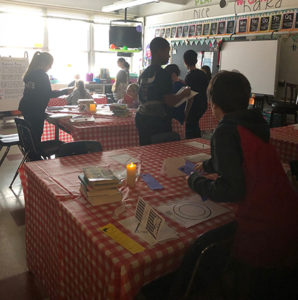
My fellow teacher, Alyssa Pogal, does a fabulous job with book tastings. I took what Alyssa did with her fifth-grade students and replicated it with my college course. The adult students loved it as much as the fifth graders. We picked books appropriate for students in the third-grade through eighth-grade, from all genres that represented a variety of cultures. The goal was to expose the adult students to a variety of books that they may use at some point with their students when they teach. We also encouraged the adult students to bring books that night, to add to our choices.
Suzanne Pettifer
Roberts Wesleyan College
Rochester, NY
I conduct book tastings the first week of school and also when we are about to begin book clubs. For the first week of school, I have five high-interest books of different genres and authors on each table group. Students choose one book and read it silently for five minutes. After the five minutes have lapsed, they answer questions on a handout I give them. It consists of five or six rows (for each book they will preview) and after briefly reading each book, students write down the title, author, what genre they think the book is, and a simple 1-10 rating with a short explanation as to why.
Students keep this sheet, as it provides options for independent reading books. If any of the books they read seem interesting, they either check it out from my classroom library or the school library. Because independent reading is at the core of my teaching, we conduct these types of book tastings a few times a year. The chosen books vary, but I try to pick YA books from the past five to seven years in a wide range of genres and authors that I and my past students have enjoyed.
Many students, when they walk into a library, have nowhere to begin and all they see are the spines of books, which can be intimidating. This activity makes reading enjoyable and fun, and even my students who don’t like to read find at least one book that is appealing.
Holly Dottarar
Lakeridge Junior High School
Lake Oswego, OR
For book tastings, I select multi-genre books for each table of students about once every other month. Giving the students approximately one quiet minute to preview and peruse, I ask students to “Quick C,” which stands for category, cover (teaser on back cover), and clip (a short paragraph near the beginning). This gives students the opportunity to test the genre, writing style, and personal interest in the story. Then, we take a minute to quick-write each student’s reason for why or why not they would select the text in a simple T-chart, and sStudents reflect on this. They learn genres and styles that work or do not work by noticing patterns in selections. It also makes for an easy book list. Student use this to set goals and challenge themselves as readers. It’s helpful for students to get to know their favorite “flavors” as well. From book tastings, students make flow charts for others, including all the books read in a semester. This helps us connect books or authors (e.g. If you like this text/author, then you will like this one) and showcases what students have read.
Carolyn Turcotte
Barrington Middle School
Barrington, IL
For a book tasting with my AP class. I worked with my media specialist in picking nonfiction texts and memoirs, looking for books with a larger global meaning. She also helped me by creating a PowerPoint of book covers and synopses. She came to the classroom the day before the book tasting to show this to the students. The next day we went to the media center where there about four or five books on a table with sticky notes. There were three to four students sitting at each table and they were given five to ten minutes to read the back cover, look at different chapters, and make notes about which books were of interest to them. They then rotated to the other tables to make sure that each student had a chance to sample each book. When at the tables you could hear the students talking to each other about the content of the texts and getting excited about various books.
Samara Zeiger
DeKalb Early College Academy
Tucker, Georgia
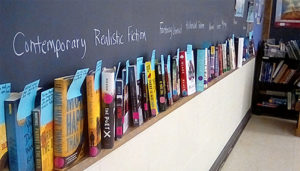
I wanted to get better at teaching genre to students. I had a list of fiction genres from Nancie Atwell’s In the Middle, but I knew it wasn’t enough to help students determine the genre of the books they read. Lori Huebner Avila, a colleague of mine, told me about book “speed dating,” and together we worked to create reader’s notebook handouts. These were handouts describing 12 different genres (nine fiction genres plus autobiography, biography, and memoir). At the beginning of the school year, I went into the library and pulled about 10 books of each genre (I combined the three narrative nonfiction genres as we had 10 tables) and put each genre group of books on a table with a laminated card with the genre title and a description of features that matched the handout.
My colleagues and I brought first-year students into the library and divided them in 10 small groups, one at each table. In addition to the genre handouts, students each had a handout “Want to Read List” with a chart for making a list of books of interest to them. Then we engaged in “genre speed dating.”
Kerry L. Thomas-Mess
Rufus King International High School
Milwaukee, WI
FOCUS ON THEMES
This year, students from all the American Literature classes from my school spent a full day in the school library taking part in a book tasting where they had the opportunity to “taste test” possible choice novels for their junior research paper. I worked closely with teachers to develop a comprehensive tasting menu of available texts, inspired by the eleventh-grade curricular theme of Social Justice, with tables themed around Service of Country, Mental Wellness, Spiritual Sisterhood, Faith In Crisis, and Minority Voices to help students get a feel for the different literary vintages that this student-centered project had to offer. After creating the menus, it was easy to set several themed tables up in the library and create a restaurant-like setting with classical music, vases of flowers, tablecloths, place mats, and napkins.
Each table was set with a menu at every plate and an arrangement of books in the center. Students were put into teams of five and they traveled to each of the tables as a team. The teams were given five minutes at each table and they gave each of the books a rating of one to five in their menus. Best of all, students were supported in making informed choices for their novels and the classes left the tasting feeling truly inspired to dig into their next steps of independent research.
Siobhan Dannaher
Bishop O’Connell High School
Arlington, VA
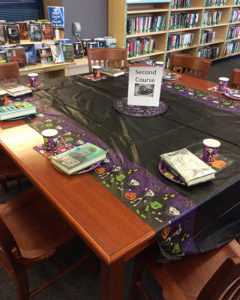
I have done this seasonally for Halloween and used seasonal decor and also Emoji-themed place settings. In addition, we have done this with Hogwarts houses. For the first two, I had teachers ask me for specific themes. The first was war and the second was religion. I placed table cards with the titles “amuse-bouche,” “appetizer,” “first course,” “second course,” and “dessert”” on the tables. Then I selected titles.
For the “amuse-bouche” table I selected books that had just a taste of the topic—for instance, a fantasy/sci fi novel with a minor plot element of a war between different tribes or galaxies. A “amuse-bouche” book for the topic of religion might be a book in which a main character’s friend or cousin has a particular religious affiliation. Then an “appetizer” was a bit more inclusion of the requested topic, and on the next two tables, first and second course, the topic was more heavily included within the book. This is where I placed books centered on WWI, WWII, or Vietnam, the French Revolution, the Mexican/American war, or conflicts in Central and South America. For religion, the “first course” and “second course” tables included books in which religion or spirituality were more central, including related topics such as cults, living on communes, characters facing religious intolerance, etc. “Desserts” were high-interest books chosen to appeal particularly to reluctant readers—not always as topic-intensive, and sometimes shorter.
To be grouped by Hogwarts houses, students could either choose a table decorated according to one of the houses, or be sorted via a Buzzfeed quiz (an online search will find a longer quiz from 2014 and a shorter quiz from 2017). Then I placed book selections on the tables based on those character attributes. For Slytherin, I picked books where the protagonist is cunning, ambitious, determined, a leader and resourceful. Gryffindor was for books in which characters show bravery, daring, chivalry, and courage. Ravenclaw was for books showing intelligence, wisdom, creativity, wit, originality and knowledge. And Hufflepuff was for books that demonstrate loyalty, kindness, honesty, and friendship. I have book lists for all of these and periodically add to them. This is an activity that I like to do with first-year students at the beginning of the year; then students will return to the library and ask for the list for Hufflepuff, for example.
Jessica Lorentz Smith
Bend Senior High School
Bend, Oregon
FOCUS ON THE DISPLAY
I initially began doing book tastings about five years ago, in collaboration with a Library Media Specialist and a teacher colleague at another school. The book tasting was used to introduce students to nonfiction books as part of a unit on informational texts. When I’ve conducted book tastings, whether in a library, classroom or other setting, the room is set up to provide the look and feel of a real cafe with tablecloths, placemats, menus, trays of books, etc. Just like in a restaurant, students’ sample or “nibble on” a book for each meal course (appetizer, entree, and dessert). Students are even shown a short video clip on a food tasting to help make the connection between a food tasting and a book tasting. At the end of the book tasting, students are also given an opportunity to share and provide feedback not only on the books sampled, but on their book tasting experience, so that I know what changes or improvements to make in the future. Since my first book tasting was conducted in the school library, students were able to check out a book they sampled before leaving the cafe/library.
Chontell Richardson
Prince George’s County Public Schools
Maryland
I collaborated with the Fairhope Public Library and Allyson Russell in the library’s teen department. Allyson brought books that we put on a table set with a tablecloth, placemats, and flower arrangements. Students previewed the book in front of them and then changed spots in a sort of “musical chairs” style, sitting down for a new book in a new spot. Allyson talked about various literary genres, and students discussed their favorites. Favorite authors this year were Angie Thomas and Sharon Flake. Students also enjoyed the I Survived series of historical fiction.
Nelda Reichley
Fairhope High School
Baldwin County, Alabama
I set up my book tasting like a cafe, with tablecloths, place mats, and menus. I even had table markers (like the ones that identify table numbers at weddings) with the book titles in them. Each table had four settings with a book and a synopsis.
I met my students outside the door and handed them each a menu that listed all of the books they were going to “taste.” During the class period, they were asked to look at the cover, then read the synopsis, then open the book at random and “taste” the book by reading two to three pages of text. At the end of the class period, I asked them to choose their top three. Students are always excited about book tastings. They love being given choice in reading.
Caroline Goetze
Saginaw Arts and Sciences Academy
Saginaw, Michigan
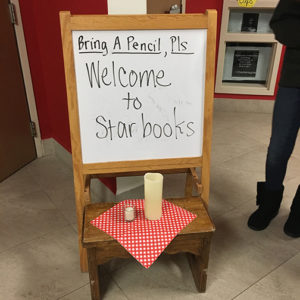
I was excited to host a book tasting for the first time last fall because although we have an amazing school library, I wanted books at my students’ fingertips and I wanted to generate interest in my own new class library as well. I made handouts and decorations with an ‘Italian Restaurant’ theme in reds and whites, including electric candles, low lights like lamps instead of fluorescent overheads, light snacks, non-alcoholic sparkling apple juice, an electronic fireplace, response forms on which the students could track the books they tasted and rate them, etc. I wore a chef’s hat and an apron all day.
I pulled from a variety of online sources for my materials, blending and adapting them for my event. Each student spent about seven minutes at each chair analyzing books, in groups of six, with five groups total. I did not arrange the books by genre; I just tried to make sure every table-group had a mix of genres, topics, etc. I felt the event really generated a lot of excitement in my students and they were engaged by the whole setup.
However, four months later, I have yet to see more than about five to ten percent of my students check out new books/eBooks/audiobooks from my class library or even our school library. Some of that is because they are not required to do independent reading during novel units (Enrique’s Journey and The Outsiders). Some of it is because most of our parents are in a position to be able to buy their students books. Nevertheless, I would still do a book tasting next year because my students enjoyed it and I hope for better results next year.
Lynda Suzanne Shanks
American School Foundation of Monterrey
Santa Catarina, Mexico
FOCUS ON COMMUNITY
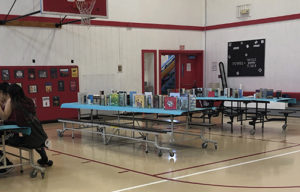
I decided to organize a community-based book tasting during my first student teaching placement in Nondalton, Alaska, a small village of around 200 people. We scheduled the book tasting for a Friday evening from 5 p.m. to 6 p.m. It was open to the whole community but based on the demographics of the people there, we didn’t expect many adult villagers to come. Some of the older students stayed after school to help us set up. We had long tables, with each one labeled for different levels of reading. We gathered pre-school through adult books from the school library and individual classroom collections. The older students wanted to contribute some of their favorite books, so they went around and added some more to our selections. We lined the tables with paper and with help from the students, drew pictures of plates, forks, and knives on the paper. On one wall, we placed pictures of popular book covers that we had on the tables.
We had coffee shop music playing, popcorn and cupcakes for snacking, and beverages, along with notecards and pencils that our guests could use to write down books they were interested in. When the event started, there were only about five students—the ones that helped us set up. But by 5:30 p.m. we had five adults from the community, and students of all ages. Our turn-out was about twenty people, which was actually amazing based on the village size. I took this as an opportunity to learn more about the older students whom I didn’t know as well, and also got to know the parents of my students.
Nicole Tener
Kutztown University
Nondalton, AK

